Vera and Donald Blinken Open Society Archives
The Forgotten Prime Minister – András Hegedüs Born 100 Years Ago
“Gerő suggested it, and Rákosi consented, adding that he had talked it over with Soviet comrades. . . . Politically, I think... my activities were very negative. Thinking about it now, I know that accepting the premiership was a bad decision,” András Hegedüs said in his 1985 oral history interview conducted by democratic opposition figure Zoltán Zsille, broadcast on Radio Free Europe and also distributed in samizdat in print. András Hegedüs, born a hundred years ago, on October 31, 1922, was appointed Prime Minister on April 18, 1955, at the age of 33, making him the youngest PM in Hungarian history. This alone would not justify commemorating him, but his career, although typical in many respects, was twistful even by 20th-century standards. Born into interwar Hungary during the Horthy era, at a very young age he concluded that only a Communist revolution could bring about decisive social change; from a fanatic communist he later turned into an opposition to the regime, expressing theories critical of the system in international forums and within the Hungarian democratic opposition.
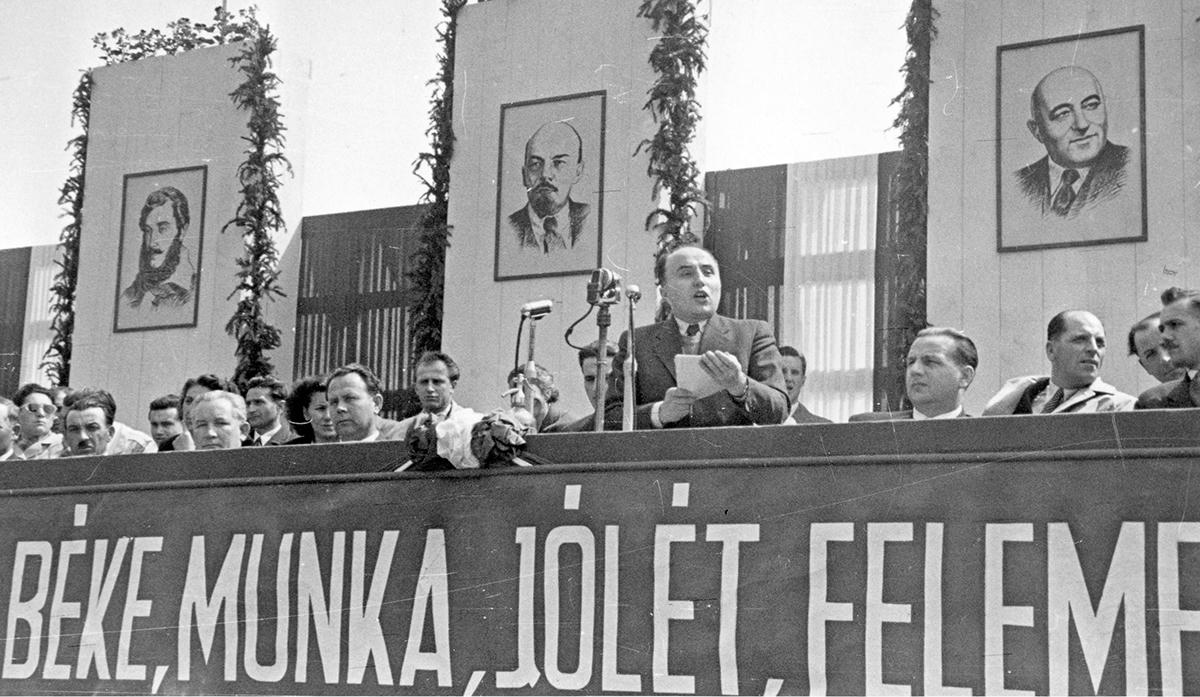
András Hegedüs giving a speech from a tribune decorated with portraits of Lajos Kossuth, Lenin, and Mátyás Rákosi, 1953
(HU OSA 361-0-15 András Hegedüs Personal Papers, Photographs of András Hegedűs as a Politician)
The son of a servant father and a mother from a peasant family, Hegedüs was well-educated; during his university years, he joined the illegal Communist movement at the age of 20, and after 1945, he was one of those young cadres, a staunch Stalinist, who rose rapidly through the ranks as the Communist Party seized power. At the age of 30, he was already Minister of State for Agriculture and Forestry, and in 1953 July, he became Deputy Prime Minister and Minister of Agriculture in Imre Nagy’s first reformist government. In office, as Ernő Gerő’s protégé, his main task was to keep an eye on Imre Nagy, blocking his “new phase” policies. With Imre Nagy sidelined, Gerő and Rákosi entrusted Hegedüs as prime minister to reverse the results of Imre Nagy’s program.
Although it is well known that in Stalinist regimes, the prime minister is not the highest position of power and decision-making, Hegedüs’ activity was still exceptionally inglorious. He signed Hungary’s accession to the Warsaw Pact, creating the legal basis for Soviet troops to remain on Hungarian soil after the Austrian State Treaty was concluded. Then, after the Hungarian Revolution of 1956 broke out, he signed the backdated note calling for Soviet troops to intervene; although, by that time, he had been removed from his post as PM. At the end of October, he was also brought to Moscow, where he took part in drafting the Kádár government's infamous November 4 proclamation—which was his last act as a politician. Regarding the 1956 Revolution, until his return home in 1958, he was clearly on the side of Rákosi and his followers, who considered even Kádár's policies too tolerant. Correspondence with his family, preserved at Blinken OSA among his personal papers, bears witness to this. The letters (a selection of which was published by the Archives in 2010) unveil the hurt feelings of Stalinists demanding retribution, who could neither understand nor forgive the people for having stood up to them.
Later, in numerous memoirs and biographies, he stated that it was a desire to understand what had happened to Hungary and its people in 1956, that eventually brought a turning point in his career. That was why, as his political career ended, he turned to sociology. The intellectual and ideological turn, the radical and critical reassessment of his own role, did not happen overnight. Following his return (or rather, once he was allowed home) from Moscow, he was assigned with setting up the Sociological Research Group at the Hungarian Academy of Sciences, the first official workshop of sociology, a discipline that the state considered suspicious. Hegedüs is remembered as a liberal leader, who mostly left it to his subordinates—often more academically qualified—to decide what to do. Moreover, the research team soon included several “highly suspicious elements” formerly convicted after the 1956 Revolution, such as Pál Lőcsei or Hegedüs’ namesake, the historian-sociologist András B. Hegedűs. Ágnes Heller also worked here, as well as future opposition members like Zoltán Zsille.

Group photo of the Hungarian Communist Party’s Central Party School, with Júlia Rajk standing in the middle and András Hegedüs second on her left, 1946
(HU OSA 361-0-15 András Hegedüs Personal Papers, Photographs of András Hegedűs as a Politician)
Hegedüs himself also drifted toward the opposition. In the 1960s, he looked forward to economic reforms still with hopeful expectations, but after the crushing of the Prague Spring in 1968, and the subsequent scrapping of the “new economic mechanism,” he turned against the regime. He protested the Prague invasion, for which he was soon dismissed from the research group. In the so-called “philosopher’s trial” of 1973, along with György Bence, János Kis, György Márkus, Mária Márkus, and Mihály Vajda, he was reproved for “anti-Marxist views,” and expelled from the party. Until his imminent retirement, he was only allowed to work as external adviser. Nonetheless, he became a regular participant in activities and public protests associated with the democratic opposition. He signed the petition protesting the imprisonment of Charter 77 activists—although Júlia Rajk, the widow of László Rajk (and the mother of László Rajk Jr.), who could never forgive Hegedüs for his role in 1956, did not join the action precisely because she saw Hegedüs’ name among the signatures.
His 1985 oral history interview on Radio Free Europe had an almost cathartic effect on the audience; a once-unrepentant Stalinist faced his own mistakes and sins, and exposed the repulsive reality and hypocrisy of the regime. In the early 1980s, he became a regular speaker at the opposition’s illegal lecture series, and a frequent guest at the very university colleges (Bibó, Rajk, Széchenyi, Eötvös) that by the end of the decade had become the breeding ground for the next generation of opposition intellectuals. “With his political activity (as a communist-Stalinist politician), he reckoned with his own strength . . . the road he had to go down, he did go down. And that is why his break with his comrades and his own past, his final decision to choose free or rather freer thinking instead of the privileges of power—at this “level” was unprecedented in Hungary, and extremely rare among leading communist politicians elsewhere,” wrote the former 1956 convict, then executive director of the 1956 Institute, András B. Hegedűs, on his death. András Hegedüs passed away in 1999 on October 23, the 43rd anniversary of the 1956 Revolution, a defining event of his life as well.
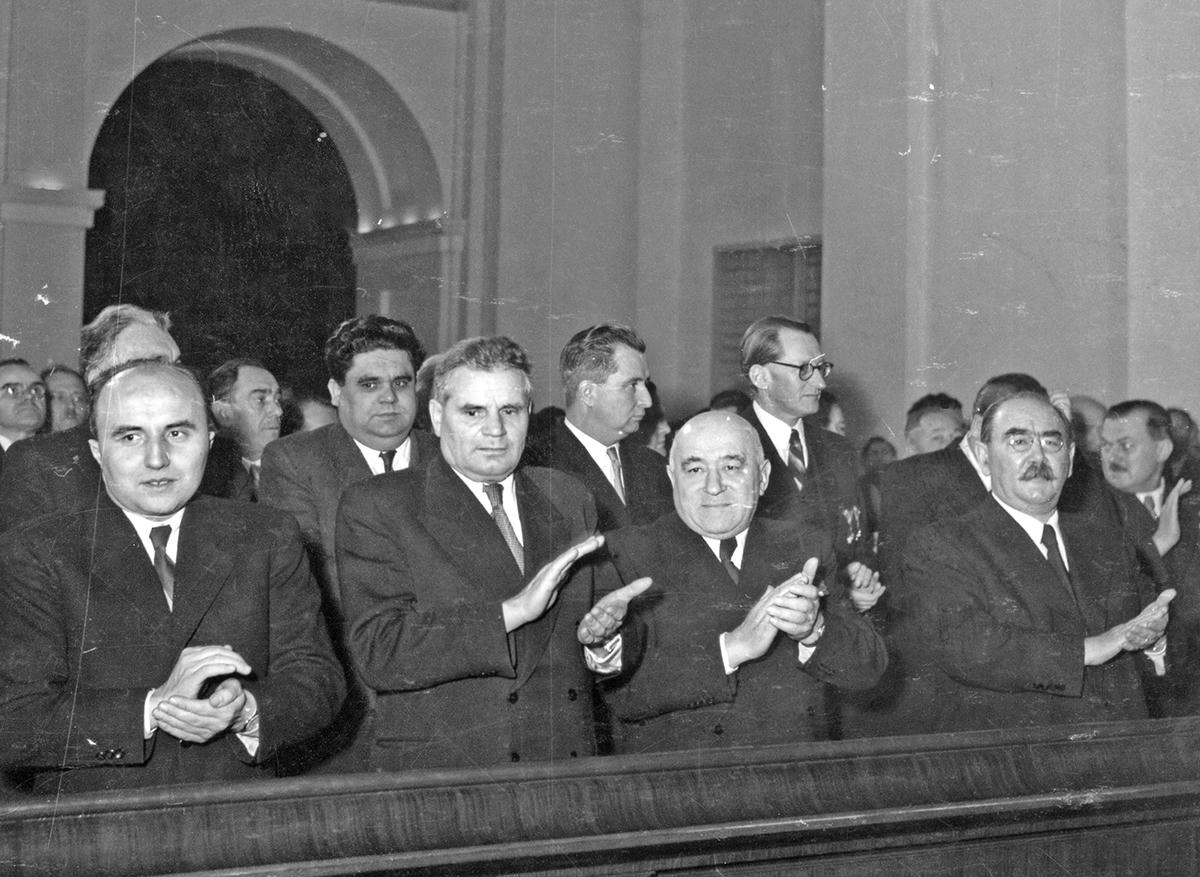
Hegedüs (l), Rákosi, and Imre Nagy (r) at a ceremonial assembly, 1954
(HU OSA 361-0-15 András Hegedüs Personal Papers, Photographs of András Hegedűs as a Politician)
While Hegedüs did support almost all opposition initiatives, protests, and petitions, he never became a member or companion of the emerging democratic opposition. The main reason for this was that his political and theoretical views were developing in a completely different direction from that of the democratic opposition. It is worth recalling the theoretical debate published in the opening issue of the Magyar Füzetek (Hungarian notes), a political and social theory journal edited by Péter Kende and published in Paris. Losing his job and being excluded from the party or the official public sphere, as described above, gave impetus to Hegedüs’ theoretical thinking. His sociological and political writings, which appeared in German, English, and Italian journals, mostly with Left-wing agendas, attracted considerable attention and earned him a reputation abroad. His essay in the first issue of Magyar Füzetek was one of these: originally published in English in 1977, it was later translated into Italian; published in Hungarian in 1978, it became an important document of the opposition’s early search for its path.
At the outset of his paper Demokrácia és szocializmus Keleten és Nyugaton (Democracy and Socialism in the East and the West), the author clarified what he meant by Socialism: “contrary to the general usage of the term, I do not mean a specific socio-economic state or socio-economic formation . . . but much more broadly the dynamics, movements, processes, and the ideas directing them, aimed at the realization of Socialist values.” As he put it, “above all, I consider such values to be Socialist . . . as the abolition of various forms of men oppressing men; the elimination of the different types of social inequality; the development of effective communities in all spheres of society, including economic life, which provide the opportunity for the emergence of authentic individuals; and, in so doing, for the extension of human freedom and the multifaceted humanization of social relations.” This definition, although conceptually and theoretically quite vague, was clearly distinct from the official definition of Socialism of the official “Socialist” regime, which may be summarized in simple terms as: state ownership + party autocracy = Socialism. (In other words, when a privileged caste, maintaining its power in a dictatorial manner and often by open violence, has no limit or restraint over the total social wealth and the goods produced.)
At the same time, Hegedüs also pointed out that the abolition of private ownership of the means of production “is of historic importance for the realization of Socialist values, despite any negative aspects.” He saw the main problem in the fact that “economic life is dominated by governmental, institutional, corporate, cooperative, and other forms of ownership of the means of production . . . the particular interests of various apparatuses . . . almost completely exclude social control; bureaucratic institutions control bureaucratic institutions. . . . A one-party power structure has been created, in which the party is not only the depositary of political power but also performs the economic integration of society, thus assuming the function of both the Capitalist market and the Capitalist state in the processes of reproduction and redistribution, making it difficult to fulfil its other functions, and rendering the imposition of centralism over democracy almost inevitable.”
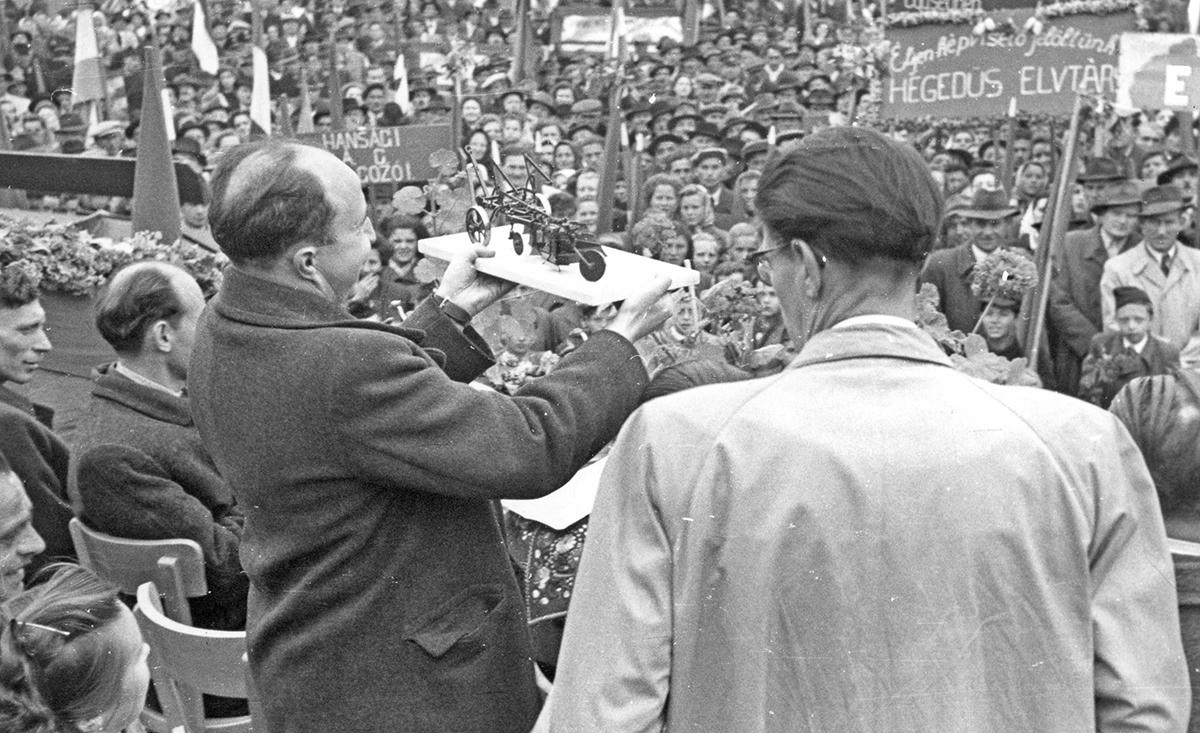
Hegedüs presenting the model of an agricultural machine, 1952
(HU OSA 361-0-15 András Hegedüs Personal Papers, Photographs of András Hegedűs as a Politician)
It may be no exaggeration to read the above as an early version of the understanding—widely popular today—of Soviet regimes not as Socialist but authoritarian state-Capitalist systems. What can one make of it if, as we have seen, the author insists on the basic tenet of Socialism, i.e., the public ownership of the means of production? The former reformer saw, on the one hand, party rule as an immovable block in the way of reforms aimed at greater autonomy for economic agents, but argued, on the other, that market reforms did not really solve anything. To the best of my knowledge, this paper was the first to indicate that economists proposing market reforms as the lesser evil of centralized control proposed, in fact, a neoliberal alternative. However, the choice between planned economy and neoliberalism is a false one, noted Hegedüs. Market reforms on a certain scale are inevitable, “but this does not invalidate the Socialist critique of commodity relations. . . . The private bourgeois ownership of the means of production cannot be restored,” nor can “the role of the market in classical Capitalism,” therefore, marketization must remain limited, but at the same time must be accompanied by a permanent and productive critique of bureaucratism.
Yet, this did not answer whether how society could exercise control over those in power. The author saw various initiatives of self-government as encouraging but ultimately failed attempts. In his writings he proposed, instead of social self-government, some form of “social rule.” He considered a multi-party system not a viable option because attempts to introduce it in Hungary in 1956 or in Czechoslovakia in 1968 had “met with great resistance” (perhaps it would have been more accurate to say that they were crushed). “The introduction of a multi-party system in Eastern Europe . . . seems possible only on the basis of a catastrophe theory . . . it would lead to unforeseeable internal upheavals, turning the region into a danger zone for war conflicts for a long time.” The deeper problem was, however, according to Hegedüs, that “none of the communist leaders opting for a multi-party system had thought through the possible consequences,” i.e., that a multi-party parliamentary democracy would necessarily entail the restoration of a Capitalist market economy based on private property, a return to a historically obsolete formation that, as stated above, was clearly undesirable for Hegedüs.
While he found pluralism to be indispensable for the realization of Socialist values, he wrote that “it is not parties fighting for power . . . that I oppose with power, but social forces that . . . exercise rule over power and the apparatuses of power.” By these he meant intellectual currents or social movements “that shape public opinion on the basis of autonomous value systems, and that can thus exercise effective criticism, control, or possibly rule over power. Only autonomous forces independent of the state can successfully combat the proliferation of bureaucracy and dysfunctional phenomena.” Hegedüs saw the emergence of the Czechoslovak Charter 77 civil rights movement, or the establishment of the Workers’ Defence Committee in Poland, as promising beginnings in the hopeful emergence of a “dichotomy of power and social rule” (at the time of writing, the Solidarity Independent Trade Union had not yet been formed in Poland).
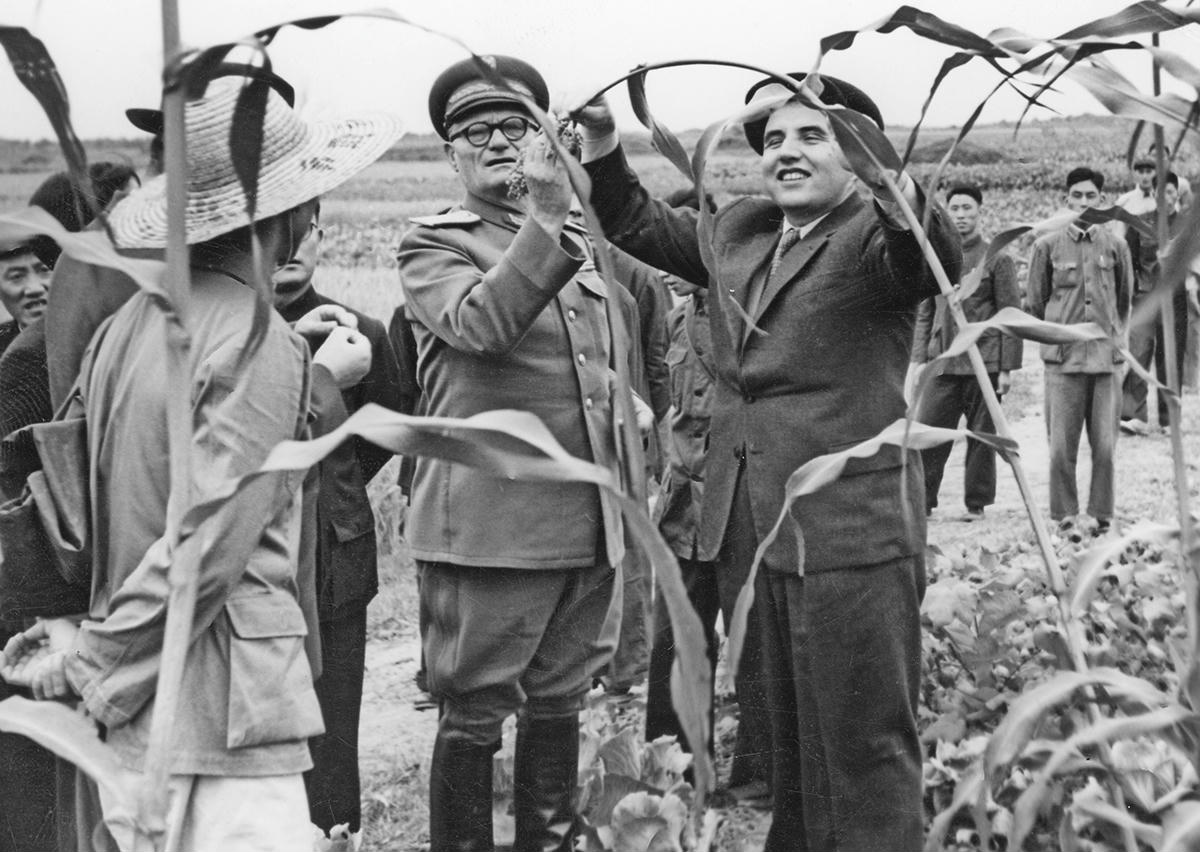
Hegedüs visiting a collective farm in Shanghai, 1954
(HU OSA 361-0-15 András Hegedüs Personal Papers, Photographs of András Hegedűs as a Politician)
Originally, Hegedüs wrote the text as an open letter, somewhat exempting himself from theoretical or conceptual criteria. Who could the pamphlet have been addressed to? On the one hand, leaders and sympathizers of Western Left-wing, Social-Democratic and Eurocommunist parties, whom the author might have tried to convince that, in their search for a democratic alternative, they must not abandon the original Socialist aspiration of socializing property and the means of production. On the other hand, the message was also addressed to the communist leaders of Eastern Europe: they should not seek a way out of stagnation, crisis, and morally unacceptable authoritarianism by combining different market elements with Socialist forms of property and economic organization. Market reforms in this environment are either doomed to failure or, if successful, will inevitably lead to the betrayal of the very essence of Socialism. Instead, they should think boldly, and integrate various forms of social rule and control into the system. Should they decline to do so, the silent warning went, the unfolding crisis would sweep away not only their despotic system but Socialism itself.
In the same issue of Magyar Füzetek, György Bence and János Kis responded to Hegedüs’ article. The co-authors of the legendary Überhaupt, key figures of the emerging democratic opposition, did not focus on Hegedüs’ economic and social theoretical ideas, but criticized the political conclusions those led to. On the one hand, they acknowledged that at that moment, in 1978, a multi-party system was not a realistic political goal in Eastern Europe. “Hegedűs . . . mentions 1956 and 1968, and hints at the ‘danger of armed intervention.’ Thinking about this, we have to admit that movements not seeking to seize power do have an advantage, theoretically at least,” they wrote. This did not mean, however, that representative democracy based on a multi-party system was not possible and desirable in Eastern Europe in general or in principle. Unless, the authors continued, those autonomous intellectual and social movements, independent of power and outside the institutional framework of power, of which Hegedüs spoke, can exert organized and powerful pressure on power on the basis of solid legitimacy and institutionalized guarantees, in moments of crisis the power may be forced to make temporary and partial concessions, but it will immediately cancel them out as soon as the tables are turned. According to Bence and Kis, either “effective pluralism is institutionalized, or the unity of power is effectively restored. And this consideration also concerns the fundamental juxtaposition of the letter. Hegedüs argues that representative democracy based on a plurality of political parties does not exercise more effective control over bureaucratic power than representative democracy based on a plurality of social movements—shall we call it that?—direct democracy. But in a representative democracy, there is an institutional way to manage open conflicts. In the Eastern European power system, there are no such mechanisms. Here, open conflict means a crisis of power.”
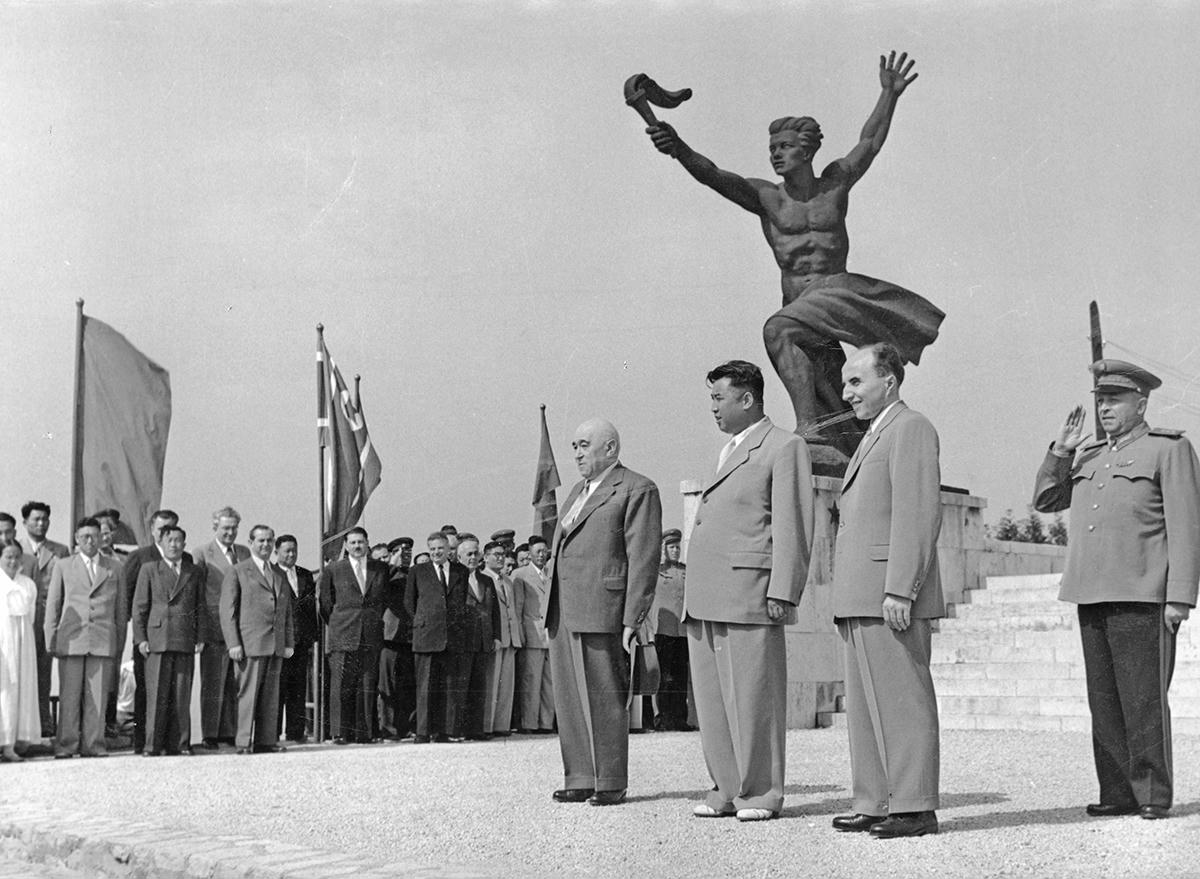
Kim Il-sung, Great Leader of North Korea, welcomed by Rákosi and Hegedüs, 1956
(HU OSA 361-0-15 András Hegedüs Personal Papers, Photographs of András Hegedűs as a Politician)
Developments in Eastern Europe in the following months and years proved Bence and Kis’ point. In Czechoslovakia, Charter 77 members were arrested and imprisoned, and the regime, until its collapse in 1989, refused to recognize the critical movements and civil rights and democracy groups as partners. In Poland, the Workers’ Defence Committee was also subject to constant persecution, and its successor, the Solidarity Independent Trade Union, was banned by the regime during the military coup in December 1981. Communist systems proved unable to coexist with social movements and organizations independent and critical of them. Control of power by social rule is unfeasible. However, there was common ground between these writings. As János Kis put it in his recent oral history interview , “Hegedüs was wrong about the institutional structure of modern democracy, or that social movements would flourish—not as a tactical compromise but as a desirable state of affairs—in combination with a strong one-party system. But he was right about the possibilities immediately ahead of us; we ourselves were thinking of creating a kind of movement he described in his open letter.”
Hopefully, it is now easier to understand why Hegedüs’ critical views and ideas of the system were shunned by the mainstream opposition during the 1980s. The scourging of the bureaucratic character of Socialist regimes and the vision of “social rule” exercised over them aroused interest in the late 1970s in Western Leftist circles that, since the fall of the New Left movements in 1968, have been looking for an alternative not only to the bureaucratic-despotic regimes in the East that called themselves Socialist, but also to the Liberal-Capitalist democracies of the West. However, with the cataclysmic collapse of Soviet-style regimes in the late 1980s, it seemed proven that there was no Third Way, that Third-Way visions were over; even if we never say for ever. More than thirty years on, in the face of today’s global crises, we can acknowledge with confidence that history has not ended, and studying the ideological and historical antecedents of critical thinking can still provide lessons.

Hegedüs giving a lecture in Innsbruck, 1971
(HU OSA 361-0-15 András Hegedüs Personal Papers, Photographs of András Hegedűs as a Politician)
The fall of the Soviet regimes did not shake András Hegedüs’ commitment to Plebeian democracy and Socialism. In 1990, he founded the Workers’ Academy, and published his book Oknyomozás válságügyben (Investigation in crisis), his last theoretical work. In its introduction he writes, “If reform thinking could overcome intellectual dullness, dogmatism, arrogance of power, conservatism, the imitation of various Western models, and not least the rhetoric of self-deluded reformers, the Eastern European type of society would be able to renew itself... I cannot give up the belief that the industrialized Eastern European type of society is only at the beginning of exploiting its historical potential. For the modernization of countries historically lagging behind, these Socialist societies can tread an alternative path to Capitalist development.” But the analysis, written with no small amount of emotion, did not attract much attention; by then, in the midst of the first parliamentary elections after the regime change, other pamphlets were the focus of interest, and Hegedüs’s theoretical work was soon forgotten.

